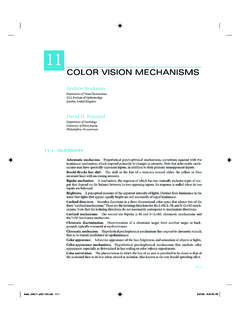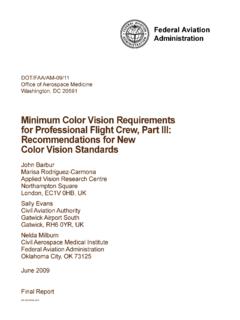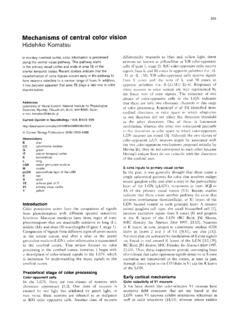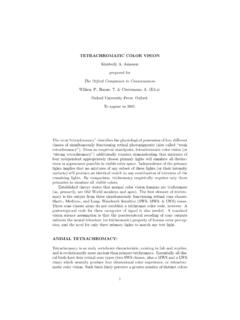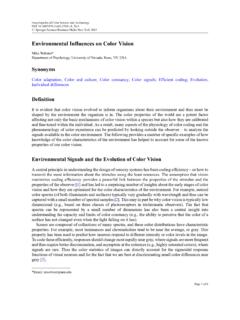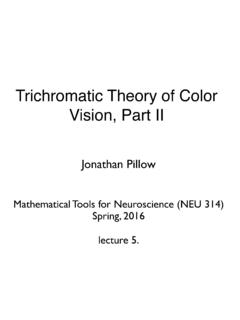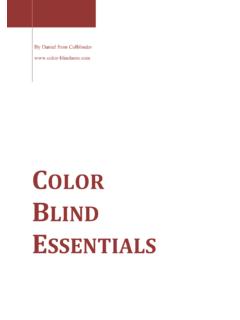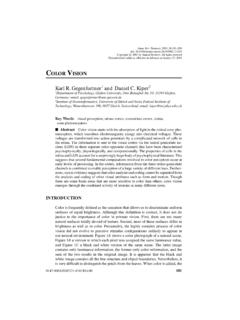Transcription of Color Vision Theory - University of Pennsylvania
1 ( , spatial frequency, orientation, motion, depth)within a local cortical region. With respect to colorvisionper se, the primary processing involves separ-ating Color and luminance information, and furtherseparating changes due to the illuminant from thosedue to visual objects, by lateral interactions over separate luminance and Color information, theoutputs ofPccells are combined in two different their outputs are summed in one way, theluminance components to their responses sum and thecolor components cancel. Summed in a differentcombination, the Color components sum and theluminance components cancel.
2 Consider a striatecortex cell that combines inputs from one or more Loand Mocells in a region. The cortical cell wouldrespond to luminance variations but not to colorvariations, since the neurons providing its inputs both re to luminance increments in the RF center and todecrements in the surround, but the Color organi-zations of its inputs are opposite to each other (onebeing L-M and the other M-L). Combined with inputfrom a Socell, this would produce a V1 cell that resto white (light increments) and inhibits to black (lightdecrements) but does not respond to pure colorvariations. This is represented in the top row of However, a V1 cell receiving inputs from both Loand Mocells, or from both Moand Locells(columns in Fig.)
3 1C), would respond to Color changesbut not to luminance variations since their colorresponses would add, but their luminance RFs, whichare opposite to each other, would cancel. This organi-zation by itself would produce L-M Color cells thatwould re to so-called warm colors (red and yellow)and inhibit to cool colors (blue and green). M-L cellswould re to cool colors and inhibit to warm shown in Fig. 1C, the further addition of Soor Socells can split these classes into separate redand yellow, and separate blue and green systems, of the primary visual information is passedthrough V1, but subsequent visual areas are partiallyspecialized for the further analysis of various differentfunctional aspects of Vision .
4 One later visual area (V4)is crucially involved with Color perception. Individualswith localized V4 lesions can still discriminate objectson the basis of their Color variations, but they reportthat the objects now appear to have no hue, as ifviewed on a black-white television screen. There is alsoa report of one case with the reverse loss: a patient whocould see colored but not black-white Color AppearanceThe appearance of a Color can be speci ed by valuesalong just three perceptual dimensions known as hue,saturation and brightness. Hue refers to the character-istic described by such Color names as red, yellow,green, and blue.
5 Saturation refers to the extent towhich the stimulus differs perceptually from a purelyachromatic ( , white, gray, black) axis. The thirddimension is brightness or lightness. That our per-ceptual space is three-dimensional re ects the basictrichromacy of normal observer can describe the hue of any light(disregarding surface characteristics) by using one ormore of only four Color names (red, yellow, green, andblue). These so-called unique hues form two opponentpairs, red green and blue yellow. Red and greennormally cannot be seen in the same place at the sametime; if unique red and unique green lights are added inappropriate proportions, the colors cancel and onesees a neutral gray.
6 Orange can be seen as a mixture ofred and yellow, and purple as a mixture of red andblue, but there is no Color seen as a red green mixture(or as a blue yellow mixture). This perceptual op-ponency is also re ected in Color contrast. Red caninduce the appearance of green into neighboringregions, and after staring at a red surface one sees agreen after-image. The yellow blue opponent pairproduces similar effects. It was these perceptualcharacteristics of Color that led Ewald Hering in thenineteenth century to propose that the various colorsystems were not independent but rather that colorwas processed in a spectrally opponent organization,an idea which has since been amply veri ed in thepresence, discussed above, of spectrally-opponent cellsin the path from receptors to the also: Color Vision Theory ; Vision , Low-levelTheory of; Vision , Psychology of; Visual Perception,Neural Basis of; Visual System in the BrainBibliographyDe Valois R L, De Valois R L 1988 Spatial Vision .
7 OxfordUniversity Press, New YorkHurvich L M 1981 Color Vision . Sinauer Press, Sunderland, MAKaiser P K, Boynton R M 1996 Human Color Vision . OpticalSociety of America, Washington, DCNeitz J, Neitz M 1998 Molecular genetics and the biologicalbasis of Color Vision . In: Backhaus W G S, Kliegl R, WernerJ S (eds.) Color Vision . Walter de Gruyter, Berlin, pp. 101 19 Spillmann L, Werner J S 1990 Visual Perception: The Neuro-physiological Foundations. Academic Press, New YorkK. K. De Valois and R. L. De ValoisColor Vision TheoryColor Vision is the ability to distinguish and identifylights and objects on the basis of their spectralproperties.
8 This entry presents several key topics thatunderlie current theories of human Color Vision . Theseare trichromacy, Color opponency, adaptation, andcolor Vision1. IntroductionInformation about Color is transformed as it owsfrom the stimulus through the initial stages of thehuman visual system. At each image location, thecolor stimulus is speci ed by the amount of power itcontains at each wavelength. The classic Color match-ing experiment shows that the normal human visualsystem is trichromatic: only three dimensions ofspectral variation are coded by the visual system. Thebiological basis of normal trichromacy is that theretina contains three classes of cone the initial encoding of light by the cones, furtherprocessing occurs.
9 Two aspects of this processing areparticularly important. First, signals from three classesof cones are recombined to form a luminance and twocolor opponent channels. Second, there is adaptivesignal regulation that keeps neural signals within theiroperating range and stabilizes the appearance ofobjects across changes of Color MatchingThe physical property of light relevant for Color visionis the spectral power distribution. A light's spectralpower distribution speci es the amount of power itcontains at each wavelength in the visible spectrum,often taken to lie roughly between 400 and 700 nm. Inpractice, spectral power distributions are measured atdiscrete sample wavelengths.
10 Let the measured powervalues be denoted byb", ,bNkwhereNkdenotes thenumber of sample wavelengths. Then the vectorb ABb"]bNkCD(1)provides a compact representation of the spectralpower distribution. Use of a vector representation forspectral quantities facilitates a variety of colorimetriccomputations ( , Brainard 1995). Wavelengthsample spacings between 1 and 10 nm are is demonstrated by the basic colormatching experiment (Wandell 1995, Brainard 1995).In this experiment, an observer views a bipartite side of the eld contains a test light. This light isexperimentally controlled and can have an arbitraryspectral power distribution.
